

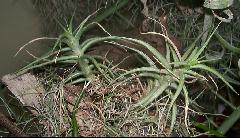


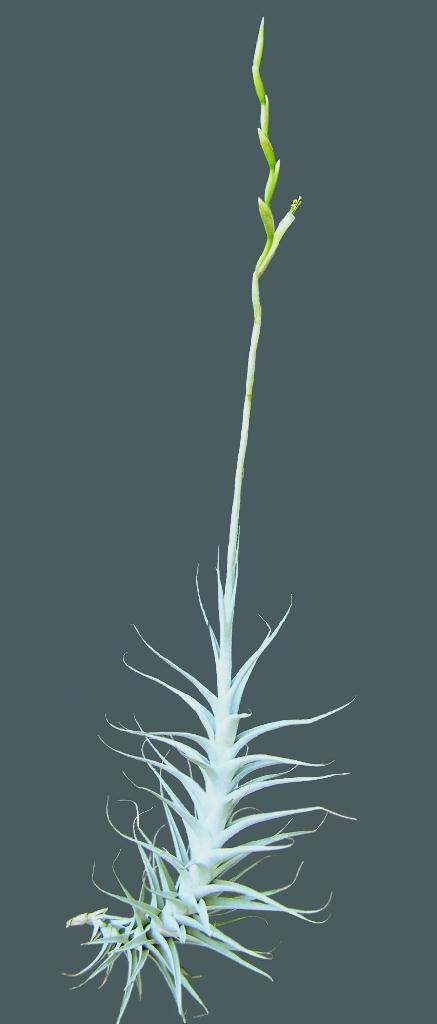

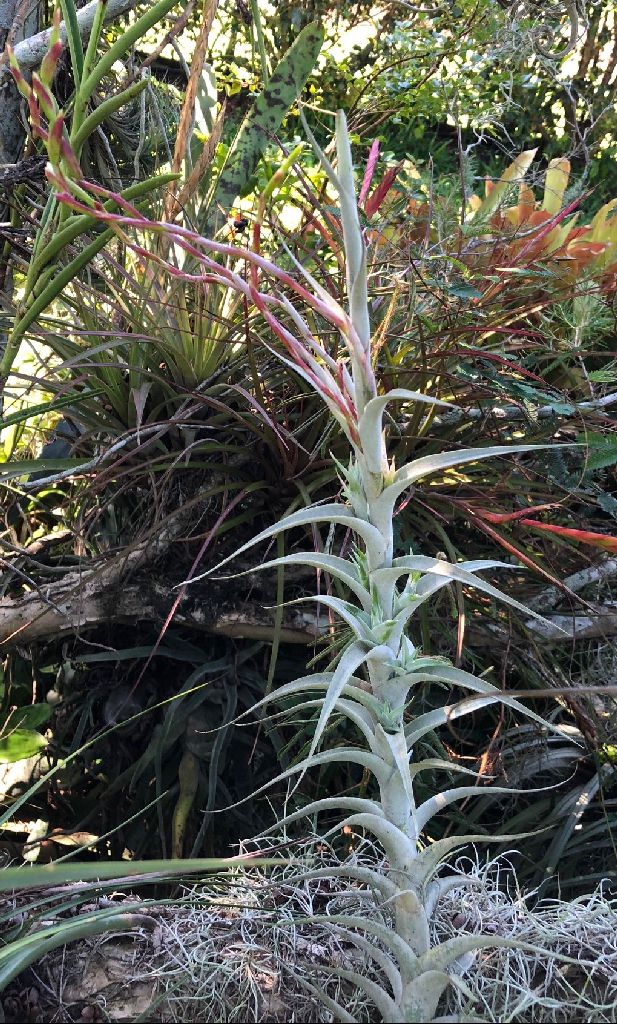
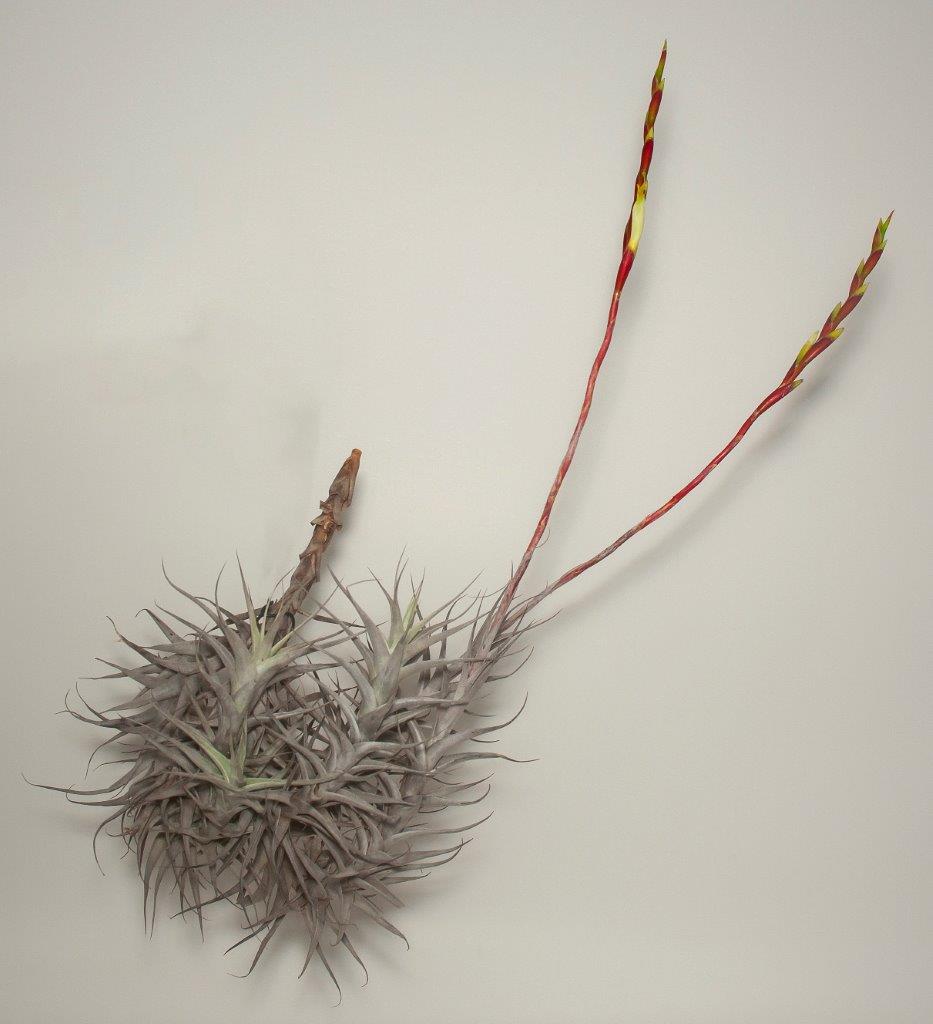

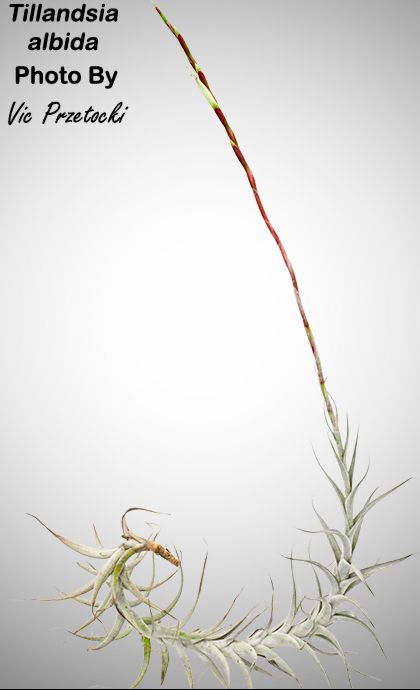
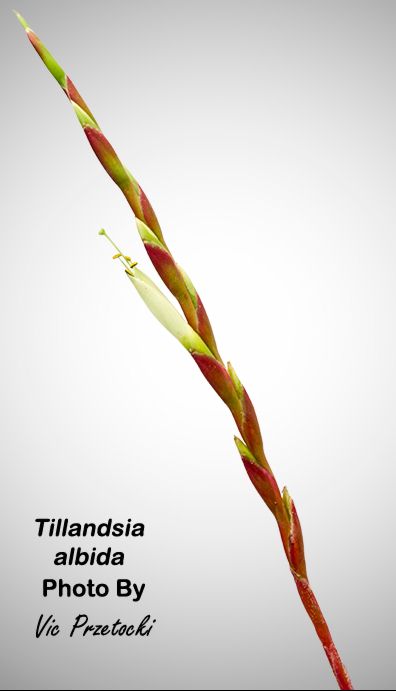
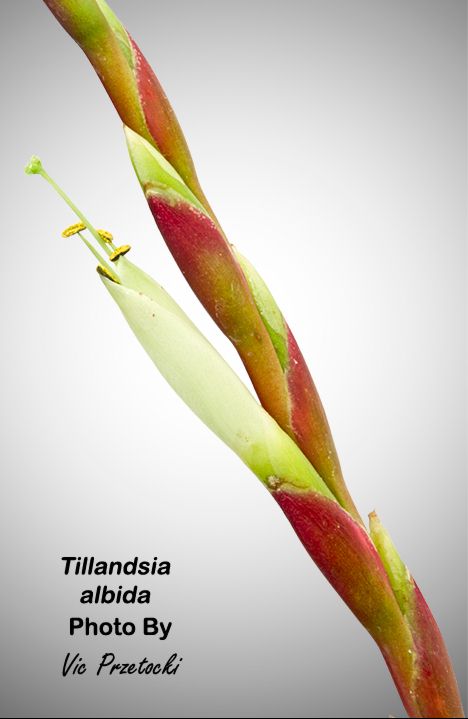
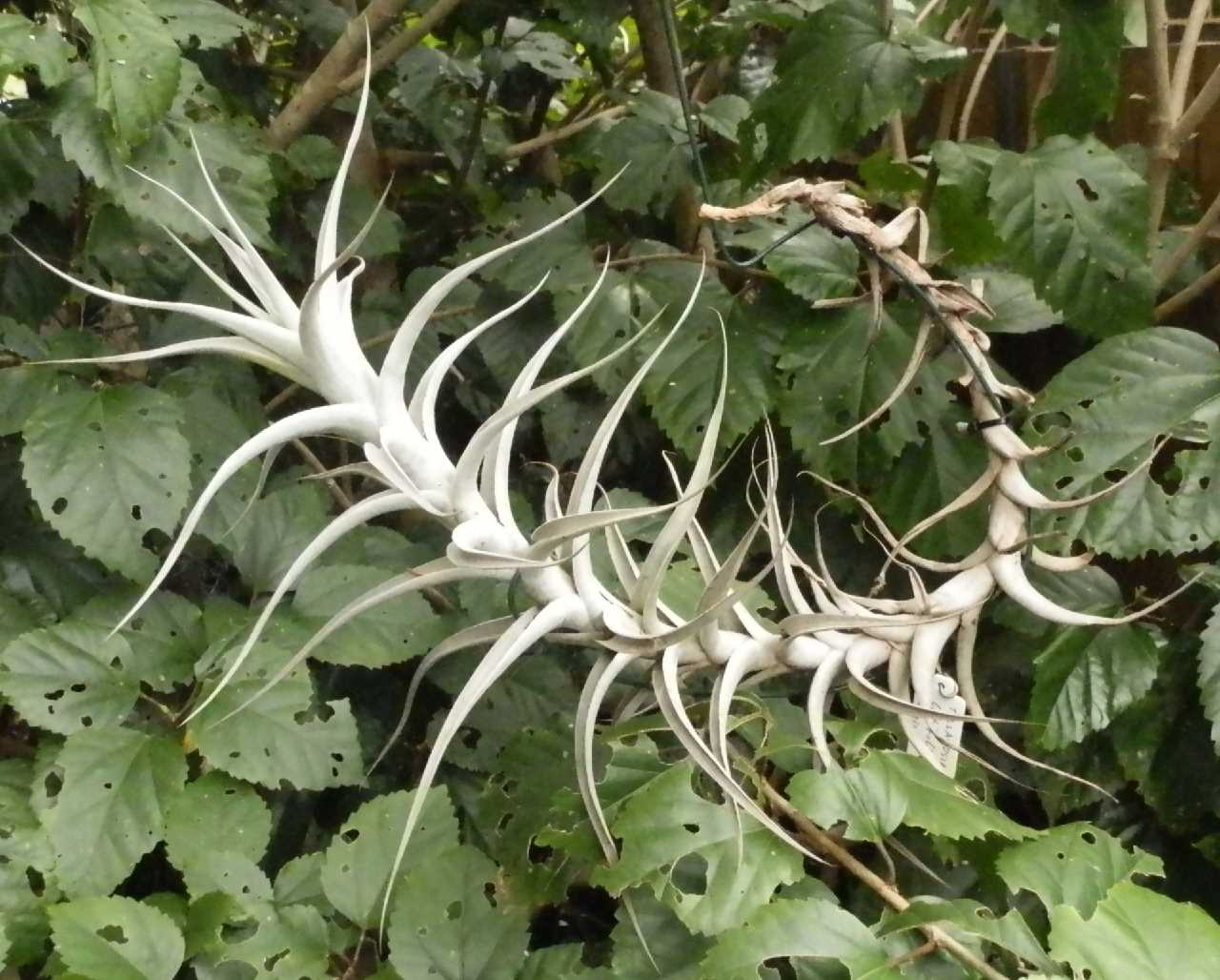
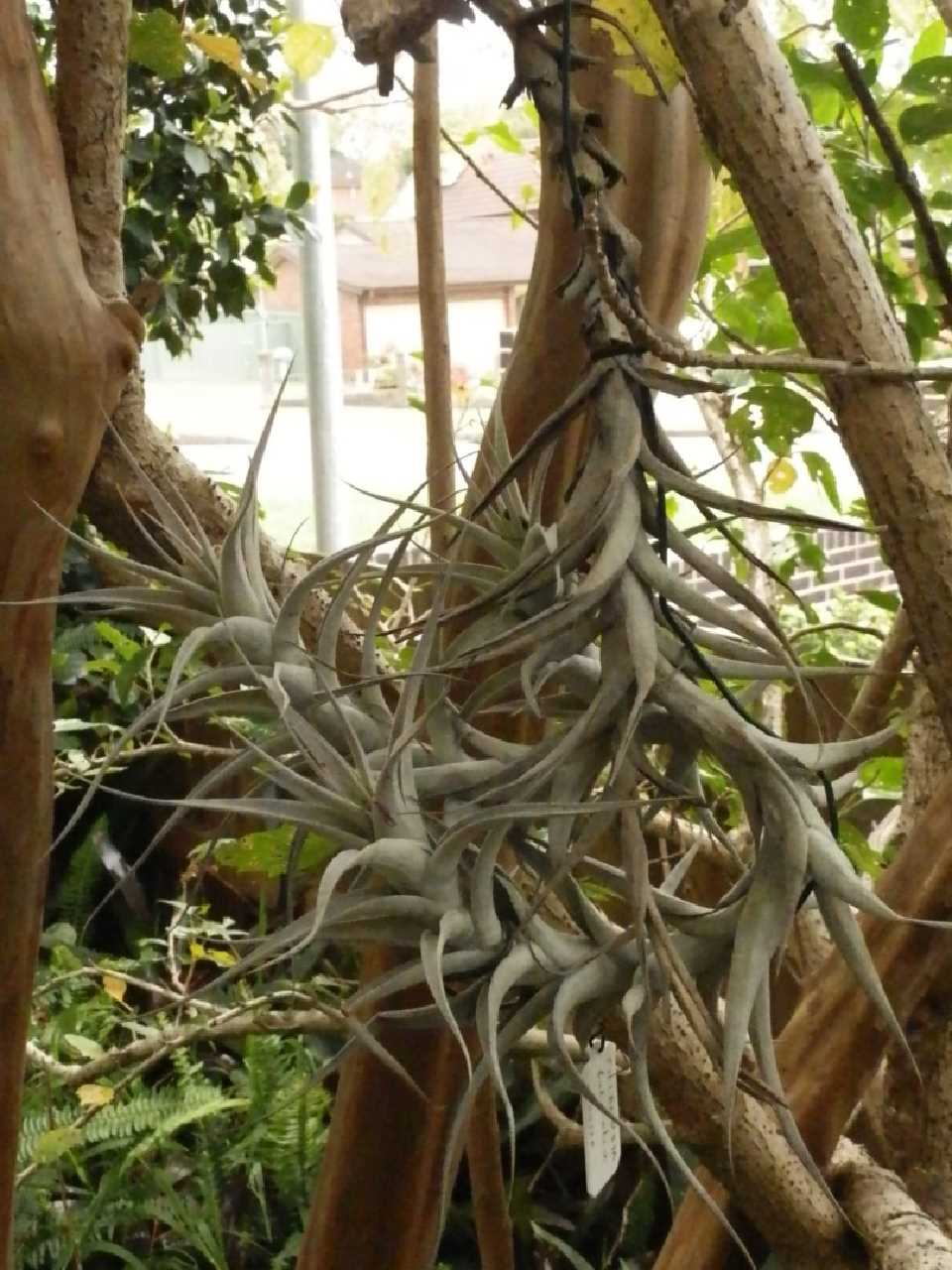
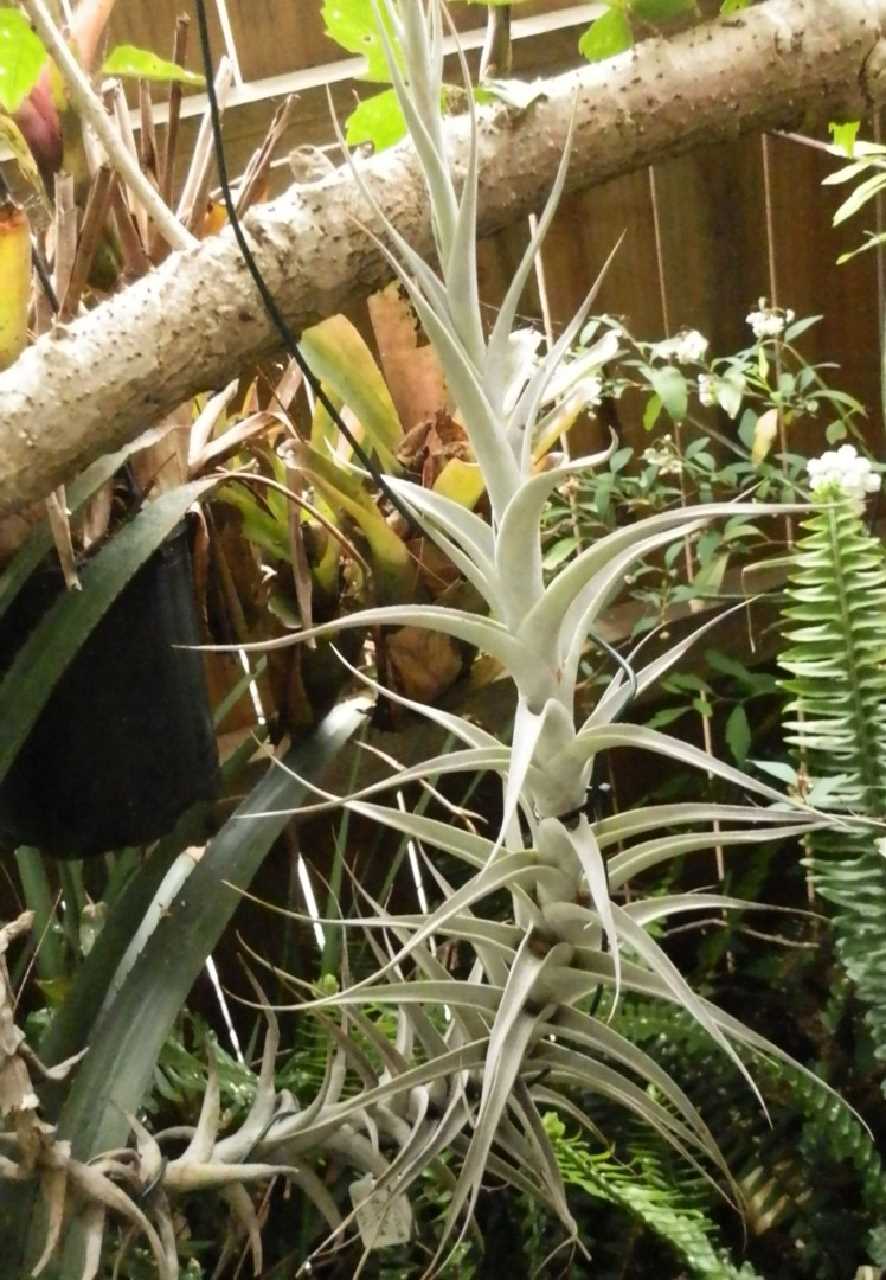
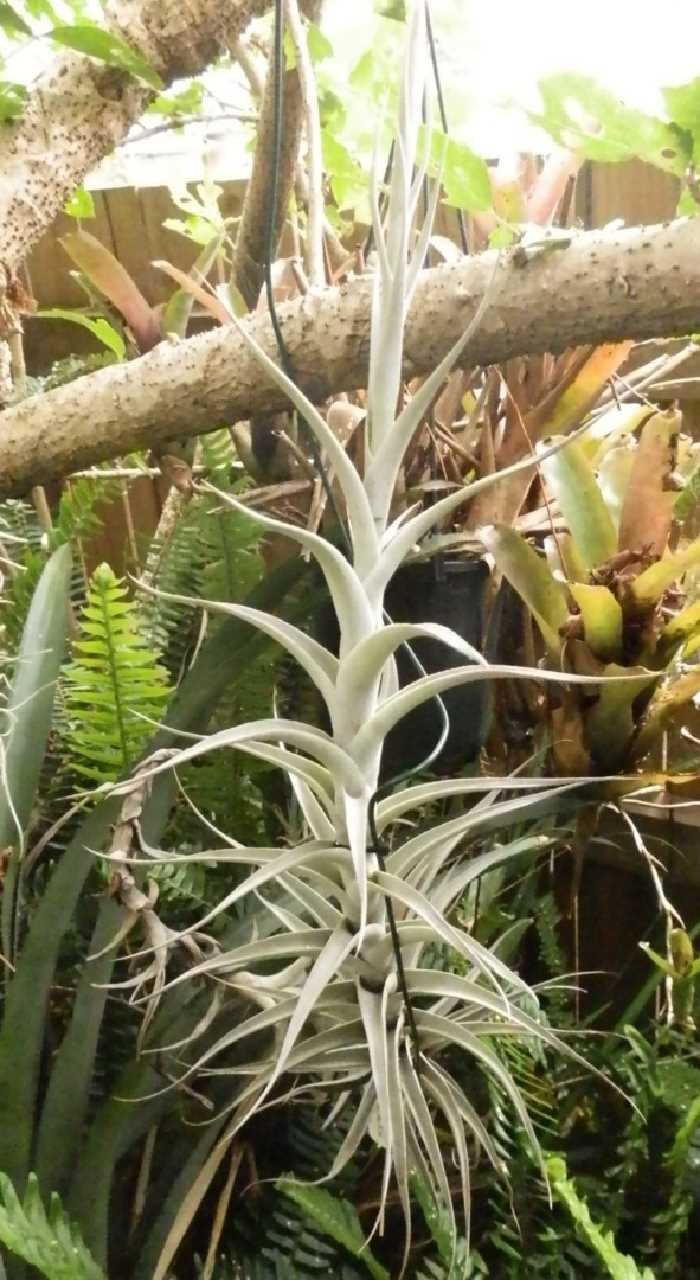
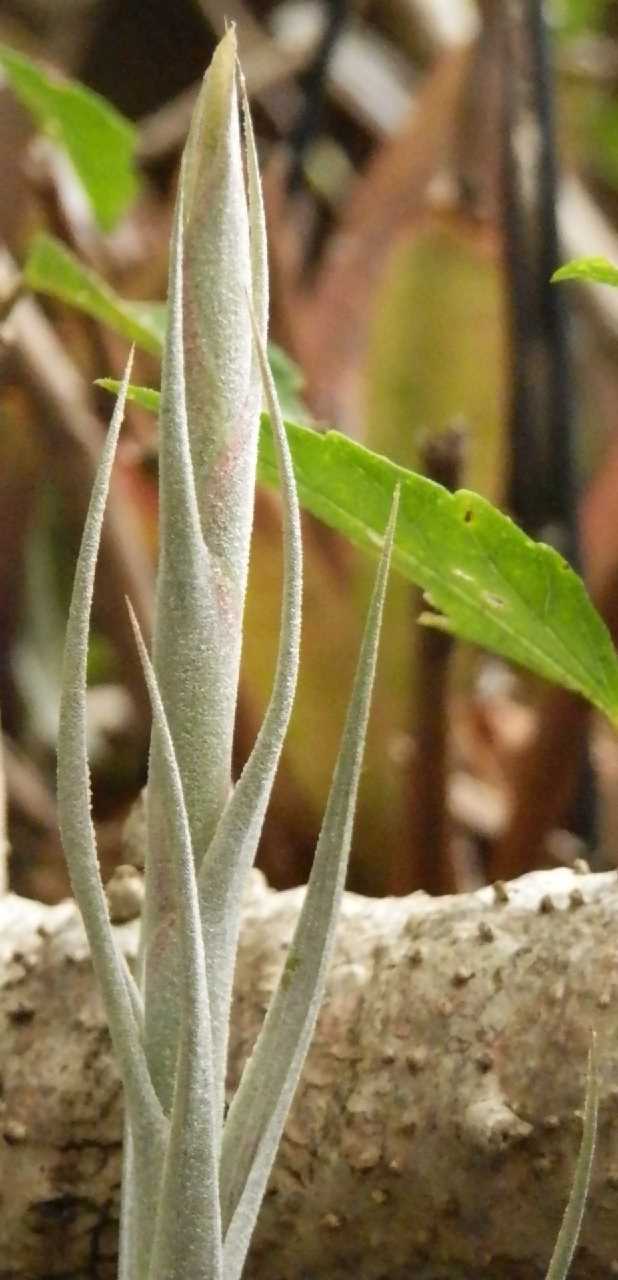
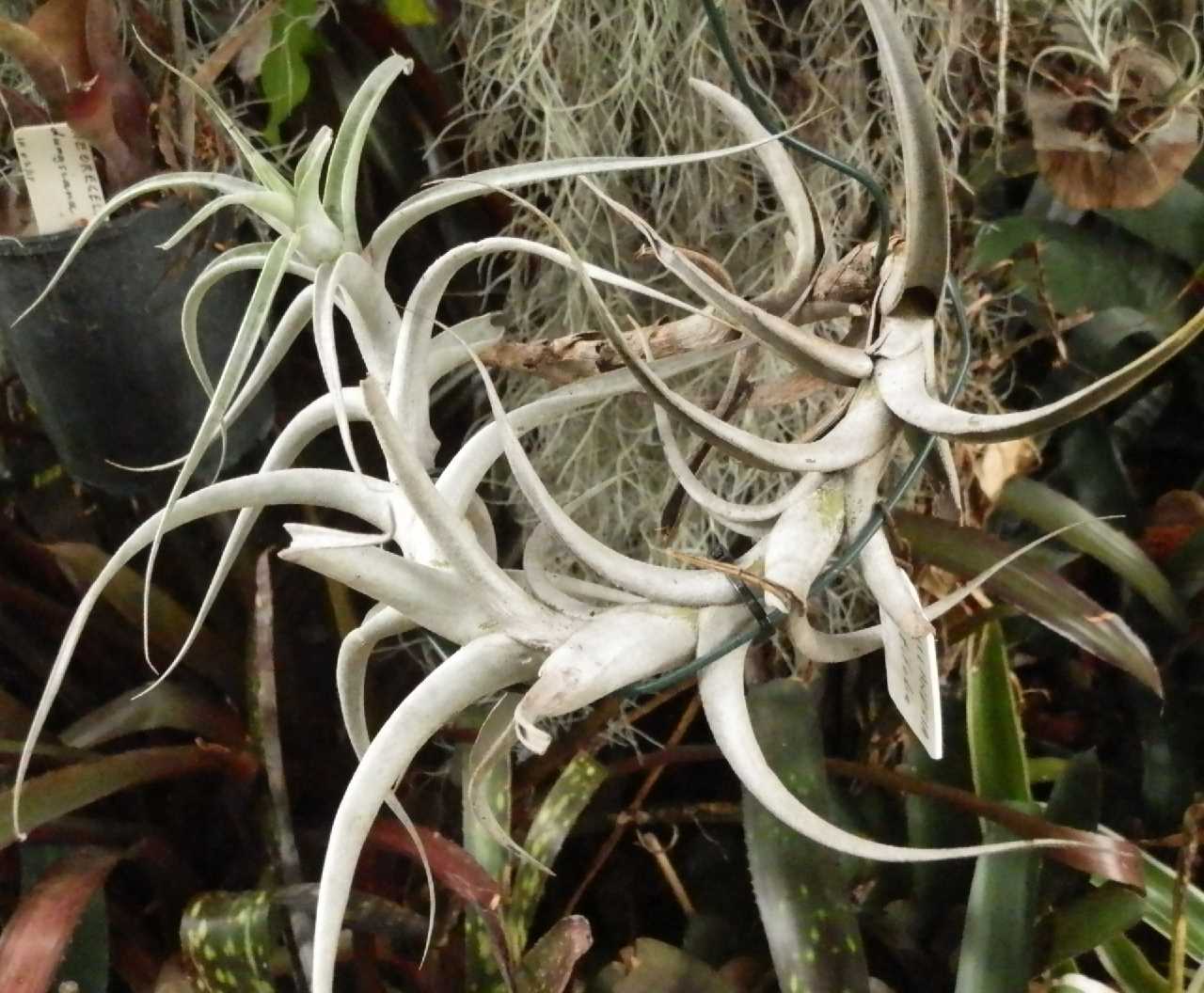
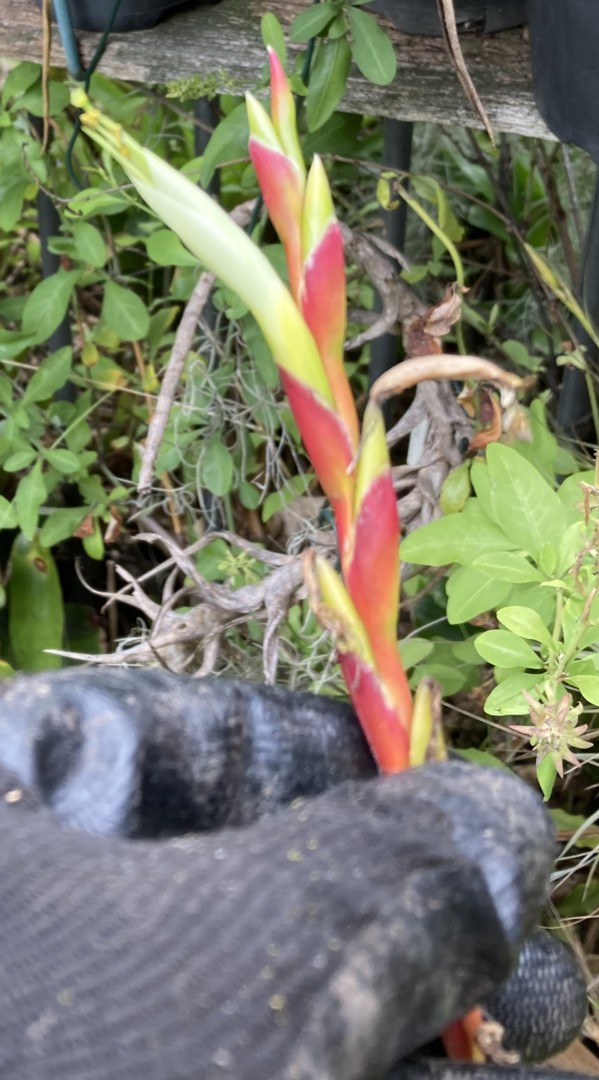
Plant lithophytic, caulescent, branched, polycarpic, caespitose, 35.8-79.7 cm high at flowering.
Leaves arching, 6.5-17.3(-30) cm;
sheaths elliptical, 14-33 x 12-20 mm, abaxially white-lepidote, inconspicuously nerved, densely lepidote, scales imbricate, appressed or extended, cinereous, adaxially nut-brown, densely lepidote;
blades narrowly triangular, 1.6-7.4 times longer than the sheath, 4.6-18.1 mm wide at base, white-lepidote, nervation inconspicuous or fine, densely lepidote on both surfaces, epidermis completely covered by scales, apex attenuate-subulate; scales on abaxial face imbricate, wings cinereous, appressed or raised, with reticulated ornamentation, margins toothed.
Peduncle erect, 1.2-3.2 mm wide at the apex, scarlet red, smooth, glabrous, flexible; basal peduncle bracts foliose, narrowly triangular, abaxially white-lepidote, finely nerved, densely lepidote, especially in blade, adaxially glabrous or sparsely lepidote, base amplexicaul, apex caudate to aristate, imbricate, apical ones lanceolate or ovate, abaxially with reddish tones, finely nerved, sparsely lepidote, adaxially glabrous or sparsely lepidote toward the center, base amplexicaul, apex apiculate to acute, remote.
Inflorescence commonly simple, rarely compound, in such a case, once divided; axis 1.6-1.7 mm wide, red, smooth, glabrous, flexible;
primary bracts lanceolate, 18.9-43.3 mm, with reddish tones, finely nerved, glabrous on both surfaces, apex apiculate;
branches 1 or rarely 2, (4.7-)8.2-37.4 cm long, erect, flexible;
rachis flexuous, with the area adjacent to the flowers flat, 0.9-2.5 mm wide in its medial part, red, glabrous, internodes 7.1-27.5 mm long;
floral bracts lanceolate to ovate, 12.8-33.7 mm long by 2.8-8.2 mm wide when folded in half lengthwise, on average longer than the internodes of the rachis, abaxially red or with reddish tones, finely nerved, the basal ones sparsely lepidote toward the margins, apical part glabrous, adaxially glabrous, base slightly amplexicaul, apex acute to rounded, margins hyaline, ecarinate, papyraceous.
Flowers distichous, 52.5-63.2 mm, appressed to the rachis, sessile;
sepals spatulate, 18-38.2 mm long, abaxially green, smooth, finely nerved when dry, glabrous or sparsely lepidote toward the margins, adaxially glabrous occasionally with some scattered scales with their wings extended, cinereous; apex rounded, margins hyaline, ecarinate, leathery;
corolla tubular, actinomorphic or zygomorphic, slightly spiraled to the height of the apex of the ovary;
petals spatulate, 38.4-49 3 x 10.7-10.8 mm, white, apex acute, erect or connivent together, in the latter case, leaving the opening of the corolla in lateral position, margins not hyaline;
stamens exserted, in 2 series of different length; filaments 47.6-50.3 mm, of the same width along their entire length, rounded transversally, pale green; anthers oblong, subbasifixed, versatile, black or brown; style exserted, 52.6 mm, longer than the stamens, pale green; stigma green, lobes conduplicate, strongly spiral, papillose.
Capsules cylindrical, 31.8-51.6 mm long, externally nut-brown, internally shiny black, smooth, apex mucronate.
Seeds spindle-shaped, brown, with 2 feathery appendages, the apical shorter than the body of the seed, the basal longer and comose.
Etymology. The specific epithet refers to the whitish appearance of the rosette, due to the dense covering of scales.
Phenology. Flowering occurs between May and August, fruiting during September and October.
Distribution and ecology. Tillandsia albida is known from Mexico, in the states of Guanajuato, Hidalgo, and Queretaro (Fig. 3), within the limits of the biogeographic province of the Mexican Plateau with the biogeographic province of the Sierra Madre Oriental (Morrone, 2005), below 21.5 N, growing on rocks in xeric scrub, at an altitude of 1200-2160 m, in arid climates.
Discussion. This species is easy to recognize, even in a vegetative state, as it is the only one within the complex Tillandsia utriculata that is branched and caulescent. However, such features cannot always be seen in the herbarium, considering that some specimens consist only of the inflorescence and are not accompanied by loose leaves. In these cases, it can be confused with T. karwinskyana or T. fresnilloensis, which are other species with simple inflorescences and are part of the same clade (Pinzon et al., 2016). Tillandsia albida can be distinguished from these species by its elliptical foliar sheaths, well defined and not gradually merging with the blade, and by its leaf scales that have reticulate ornamentation in the wings and are not smooth. In addition, the appearance of the leaf blade is appressed-lepidote, while in the other two species it is tomentose-lepidote. A difference with respect to T. karwinskyana is that usually the floral bracts are abaxially glabrous, whereas in T. albida they are sparsely lepidote. Tillandsia fresnilloensis also has floral bracts abaxially lepidote, but its flowers are slightly extended and not completely appressed to the rachis as in T. albida. Tillandsia pringlei is another species that, although normally with compound inflorescences, may occasionally have simple inflorescences and be confused with T. albida, in the absence of the rosette. In these cases, T. albida differs from this species by having floral bracts adaxially glabrous or sparsely lepidote and not densely punctulate-lepidote as in T. pringlei.
The height of the plant in bloom is variable, from 36 to 80 cm. Plants normally produce a single inflorescence, although two specimens observed produced two branches. The color of the inflorescence is variable, from green with tones of rose to bright scarlet red. Floral bracts can be densely lepidote or sparsely lepidote, and even glabrescent in some specimens, although in general, the more basal ones always have scales; adaxially they can be glabrous or with some scattered scales, which usually are lost. The symmetry of the corolla also shows variation: in some individuals the apices of the petals are erect, while in others they may be connivent, leaving the aperture of the corolla laterally, in a manner similar to the corolla of Tillandsia utriculata.
A type specimen label was found, probably written by C. A. Purpus, which reads "Tillandsia cinerea Baker." This name is apparently not published validly, as it is not found in Index Kewensis or Gray Card Index IPNI (2018). However, two homonyms by different authors have been published. The first is T. cinerea Raf., published in 1840, cited as being distributed in Florida, which would be a synonym of T. recurvata (L.) L., due to the similarities with the description: plant pruinose, villose, gray, with leaves caespitose, recurved, filiform, and plant "4 to 6 inches high" (Rafinesque, 1840: 198).
The second involved name is T. cinerea Mez, which was published in 1896 (Mez, 1896) and is considered by Smith and Downs (1977) as a taxonomic synonym of T. exserta Fernald, with which it coincides here, after observing the type specimen of T. cinerea Mez: Palmer 805 (GH). Thus, T. albida is the only name that can be applied to this taxon.
Additional specimens examined. MEXICO. s. loc.: 1973, Roth & Hal 99 (HAL); Sep. 1989, Till in Hort. Bot. Vindob. B 171/82 (WU); Sep. 1989, Till in Hort. Bot. Vindob. B 537/82 (WU); Sep. 1989, Till in Hort. Bot. Vindob. B 544/82 (WU); 30 Apr. 1990, Till in Hort. Bot. Vindob. B 12/87 (WU); 3 June 1993, Zecher 6/86 (WU); Mar. 1994, Till in Hort. Bot. Vindob. B 12/87 (WU); 13 July 1995, Till in Hort. Bot. Vindob. B 12/87 (WU); July 1992, Till in Hort. Bot. Vindob. B 2/91 (WU); Till in Hort. Bot. Vindob. B 12/87 (WU); Blass s.n. (WU). Guanajuato: Mpio. Tierrablanca, 7.5 km despues de Tierra Blanca, rumbo a Victoria, 1751 m, 17 Oct. 2001, Lopez-Ferrari et al. 2952 (CICY). Hidalgo: Mpio. Metztitlan, barranca de Metztitl an, 1200-1500 m, 11 Oct. 1995, Matuda 38486 (MEXU); Mpio. Metztitl an, barranca de los Venados, 1200 m, 23 Aug. 1975, Hromadnik & Hromadnik 1084 (WU); Mpio. Metztitl an, 2 km sobre la desviaci on a Metztitlan, a partir del puente Rio Venados, 1380 m, 11 Oct. 1995, Lopez-Ferrari et al. (XAL); valle de los Venados, 18 June 1999, Till in Hort. Bot. Vindob. B 2/91 (WU). Queretaro: Vizarron, Mar. 1982, Ehlers & Ehlers 816 (HAL), 3 June 1993, Till in Hort. Bot. Vindob. B 183/93 (WU); Mpio. Toliman, Toliman, 1550 m, 7 June 1995, Zamudio 9040 (QMEX); Mpio. Toliman, 14 km al S de San Miguel Palmas, 1550 m, 7 June 1995, Zamudio & Perez 9504 (QMEX); Mpio. Penamiller, 2 km al S de Pena Blanca, 1400 m, 25 July 1997, Zamudio 5314 (MEXU); Mpio. Cadereyta, desvio hacia La Tinaja de la carretera federal 120, 1658 m, 14 July 2006, Ramirez & Zamudio 1414 (CICY); sobre la carretera San Juan del Rio-Rio Verde, valle del Vizarron, Zecher s.n. (WU); Vizarron, Schatzl s.n. (WU).
Tillandsia albida Mez & Purpus ex Mez, Repert. Sp. Nov. 14: 248. 1916.
Desc from S&D p1015
Plant strongly caulescent, flowering to 4 dm high; stem elongate, much branched.
Leaves densely polystichous-ranked, 12 cm long, densely pale-cinereous-lepidote;
Sheaths merging imperceptibly into the blades;
Blades suberect to squarrose, narrowly triangular , long-attenuate, channeled above but not convolute.
Scape terminal, erect, short but exceeding the leaves;
Scape-bracts densely imbricate, bright-red, white-lepidote.
Inflorescence 13 cm long, 3 cm wide, laxly 6-flowered;
Rhachis undulate, angled, glabrous, bright-red.
Floral bracts erect, not at all imbricate nor concealing the rhachis, elliptic, obtuse, up to 21 mm long, much exceeded by the sepals, coriaceous, nearly or quite even with a hyaline margin, ecarinate, especially the lower ones appressed-lepidote;
Flowers erect, with short stout pedicels, 37 mm long without the genitalia.
Sepals equally subfree, obtuse, 20 mm long, coriaceous, glabrous, even, pale-green;
Petals greenish-white, obtuse, tubular-erect;
Stamens and pistil 5 mm longer than the petals.
Type. Purpus 38 (holotype B), Ixmiquilpan, Hidalgo, Mexico, 1902.
DISTRIBUTION. At 1300- 500 m alt., Hidalgo, Mexico.
MEXICO. HIDALGO: Canada de Meztitlan, 17 Apr 1891, Maury 5748 (F, GH). WITHOUT LOCALITY: Cultivated, Atkinson 40 (GH); Barry 68 (GH, US).